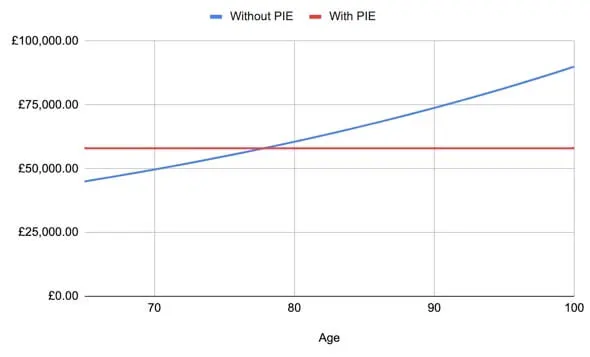
Should I accept a Pension Increase Exchange? The pros and cons of PIE offers
When considering a Pension Increase Exchange (PIE) offer, it’s crucial to weigh the pros and cons carefully. A PIE allows you to swap future inflation-linked increases on your Final Salary Pension for a higher initial income. While this can provide immediate financial benefits, it may also impact long-term security.
With many of the UK’s biggest private-sector employers struggling with pension deficits, growing numbers have approached their workforces with pension increase exchange offers.
These proposals, also known as PIE offers, are deals to buy out some of the inflation proofing on your future pensions, in exchange for a bigger starting, but flat, income.
In recent years, companies such as BT Group, Diageo, Scottish Power and Invensys have sought to use them to swap an uncertain cost in the form of index-linked rises for a more certain cost, in the form of a book of level pensions.
While it is highly appealing for the employer, they wouldn’t offer it otherwise, the financial case is far less clear cut for the members of such schemes.
What we will cover in this post
1 What exactly is a pension increase exchange?
2 Pension increase exchange – Starting point
3 Where is my crystal ball?
3.1 Life expectancy
3.2 Inflation
4 Other factors to take into account when considering a pension increase exchange
4.1 What exactly are you giving up?
4.2 Taxation
4.3 Spouses pension
4.4 Health
4.5 Family history of longevity
4.6 Other assets or sources of income
4.7 Financial strength of employer backing the scheme
4.8 Lifetime allowance impact
4.9 It is irreversible
5 When might a pension increase exchange make sense?
6 Pension increase exchange case study
7 Conclusion

What exactly is a pension increase exchange?
When you are in receipt of a final salary pension, the law requires your scheme to increase your pension each year. This is done to take account of inflation and is subject to various caps and restrictions.
However, they only have to increase the part of your pension you built since 1997. Similarly, there is a cap on the annual increases that they have to pay when inflation is high.
In practice, many schemes offer more generous inflation protection than the minimum required by law.
For example, they may link the whole of your pension to inflation and not just the bit that you earned since 1997.
When a scheme offers you a PIE, what they are doing is giving you the chance to give up your entitlement to those additional ‘non statutory’ rights. I.e. the ones offered you voluntarily under the terms and conditions when you signed up, not any of the ones required by law.
This offer can be made when you are already receiving your pension, or are about to start receiving it.
The benefit of accepting such an offer will be the payment of a higher starting pension (or immediate pension if you already receiving it).
The drawback is that, over time, your pension will allow you to buy less and less as payments remain flat while the cost of goods increases.
Pension increase exchange – Starting point
The starting point in considering any PIE offer is to remember that is isn’t being made because you asked for it.
It also isn’t being made out of the goodness of anybody’s heart and it is not being made with your interests at the core.
Company pension scheme administrators generally make these offers because it improves the funding position of the scheme as well as reducing risk by limiting their exposure to long term increases in inflation.
They will not be making the offer unless they think that they will come out ahead as a result of you and other members accepting it.
That does not mean that it will not be in your interests too. It may well be and I will cover the instances where it may be a good deal for you below.
Where is my crystal ball?
When it comes to assessing the merits of a PIE offer, there are two big unknowns: your life expectancy, i.e. how long does your pension need to last and what will inflation be in the future.
Big corporate pension departments have access to actuaries, economists and statisticians to help them crunch these numbers. Most members have no such resources at their disposal.
Life expectancy
The longer that you live, the less attractive the PIE offer will be.
However, we mortals have a tendency to seriously under-estimate our life expectancy.
You should give serious consideration to the consequences of living longer than you expect.
Inflation
Over time, accepting a PIE offer will mean that the purchasing power of your pension income will be eroded by the effects of inflation.
If the pension in payment currently increases by RPI for example, a return to moderate inflation levels of 3-4% could see the benefit of that one-off PIE increase vanish.
If your boss offered you a large pay rise on condition that you never got another one, would you take up the offer? That, in effect, is what a PIE offer is.

Other factors to take into account when considering a pension increase exchange
What exactly are you giving up?
How much are your pension payments going to increase by in retirement assuming you do not accept the PIE offer? RPI? CPI? Is there a cap?
Taxation
A higher starting pension now could possibly push you into a higher tax bracket (e.g. from the 20 per cent to the 40 per cent band). This would reduce the value to you of any PIE uplift.
This would be a particular issue if you are still in some form of paid work and the enhanced pension would be in addition to your wages.
Spouses pension
Accepting this kind of offer is also likely to affect the payouts that your spouse will receive if you die before them.
Therefore, if you are married or in a civil partnership, it is important to consult your partner on their wishes.
Often, a spouse will need to provide their signed consent to such an offer.
Health
If you are in poor health then you might welcome the chance to bring forward some extra pension to enjoy now.
If you are in good health then the inflation protection is potentially more valuable.
Also, if you end up needing expensive care later in retirement you might wish you had stuck with a pension that went on rising through your retirement.

Whether you’ve recently become an expat, are in the process of planning to leave the UK, or have been a long term expat and are now preparing to return home, estate planning is essential. Ask yourself: if something happened to you tomorrow, would your spouse or family know where to find your key financial documents?
Family history of longevity
If you come from a family where previous generations were long-lived then you might think that decades of generous inflation protection is a better option than a higher starting pension but decades of lower increases.
Other assets or sources of income
If this pension in question is your only source of income in retirement then the PIE offer is potentially less attractive.
If you have other pension schemes, sources of income or assets to draw on then taking the risk of greater short term income in return for a relatively lower income in later life may have more merit.
Financial strength of employer backing the scheme
Pies could be especially attractive if you are concerned about the schemes financial strength.
If you are concerned about the status of the employer backing the scheme, then having a higher pension now may well be attractive as you get your value out earlier.
It might also be useful in the event that the scheme were to go insolvent and enter the Pension Protection Fund. In such a scenario, your compensation would be based on the enhanced pension.
Lifetime allowance impact
At the point of retirement, an individual receiving an increase in their pension as a result of a PIE will have a higher initial pension. As a result, a higher proportion of that individuals Lifetime Allowance (LTA) will be used.
The way that the capital value of a defined benefit pension is calculated is by multiplying the initial annual pension payable by a factor (usually 20). The higher the initial pension, the higher the capital value.
Let’s use an example. Mr. Smith is in line for a pension of £45,000 from his final salary scheme. Using a factor of 20, this would give him a capital value of £900,000. This is below the current (2020/2021) LTA of £1,073,100.
Therefore, assuming he has no other pensions, he is within the LTA, even though his pension increases every year with inflation.
However, now he has been offered a PIE, which would give him an annual pension of £58,000 which would be fixed for life.
Using the same factor of 20, he now has a capital value of £1,170,000. This is over the LTA and exposes him to a charge of 25% of 55% of the excess amount.
Impact on LTA protections
Where things get slightly more complicated is if you have certain forms of LTA protection.
In particular, if you have enhanced protection or any of the variants of fixed protection.
The reason for this is that, if benefit accrual is deemed to have occurred under these arrangements, this valuable protection may be lost.
Accepting a PIE offer could be considered as benefit accrual.
It is irreversible?
Once you have signed up to the exchange scheme, you cannot change your mind in future years.
It is a flaw in the pension system that the value of payments peaks in later years. Most people don’t need the highest income when they are 94. They need it earlier, when they are more likely to still be fit and active
When might a pension increase exchange make sense?
• If you prefer to have more money in the early years of retirement. I.e. when you may be better able to enjoy it.
You could make better use of that extra money for the first few years while younger and in good health. Then, when aged say 80 plus, when you are likely to be less physically active, you may not be spending so much anyway.
Why not take the extra earlier and spend it on something that makes good memories? Something that you can enjoy now rather than worry about losing out in 30 years time.
• If you have benefits under multiple pension schemes, then you could use a PIE to bridge a gap in income until future state (or other pension scheme) benefits become payable;
• If you have no dependants or suffer ill-health. Then you may prefer to extract more value from your pension sooner;
• If you need increased flexibility. This would allow you to retain the security of a final salary scheme but also gain earlier access to more of your pension fund.

Pension increase exchange case study
Let’s look at Mr. Smith again, who is in line for a pension of £45,000 from his final salary scheme, with the usual index-linking, but who has been offered the alternative of a £58,000 annual pension that will be fixed for life.
Mr. Smith is 65 years old.
First, let us assume that the Bank of England keeps inflation at its 2 per cent target. (We’ll also assume for simplicity that the CPI and RPI figures are the same – the Bank targets CPI but pensions tend to rise in line with the RPI.)
With inflation at 2pc, it will take a £45,000 pension 14 years to rise to £58,000.

It will take a further 12 years – 26 in total – for Mr. Smith’s total income received to exceed what he would get with a flat rate of £58,000 a year.
If he lives for 30 years, his income will be £81,511 a year. This is £23,511 more than it would be without index-linking.
His total income over 30 years of retirement would be £1,907.074, compared with £1,740,000 if he opted for the fixed £58,000 annual pension.
Higher inflation?
What if the Bank of England fails to meet its target and inflation averages 4 per cent per annum?
Then, it will take a £45,000 pension just seven years to rise above £58,000, and a further six years for the total income received to exceed what he would have got with a flat rate of £58,000 annually.
If he lived for 30 years, his final income would be £177,574 a year – £119,574 more than he would have got without index-linking.
The total income over 30 years of retirement will be £3,391.924, compared with £1,740,000 had he opted for the fixed £58,000 pension.
FAQ: Should I Accept a Pension Increase Exchange (PIE)?
1. What is a Pension Increase Exchange (PIE)?
A Pension Increase Exchange (PIE) is an offer made by a pension scheme to give up future inflation-linked increases in exchange for a higher starting pension. This means that while you receive more income initially, your pension remains flat and will not rise with inflation.
2. Why are companies offering PIEs?
Employers offer PIEs to reduce their pension liabilities. By removing the obligation to provide inflation-linked increases, they gain more financial certainty. While this benefits the company, whether it is beneficial for you depends on your individual circumstances.
3. What are the main pros of accepting a PIE?
Higher initial pension income, which may be useful in the early years of retirement.
Certainty of income, since the amount is fixed and not subject to inflation variations.
Potential benefit for those with shorter life expectancy, as they may receive more pension income in their lifetime.
Might be helpful if the pension scheme is underfunded, as you get more money upfront.
4. What are the main cons of accepting a PIE?
No inflation protection, meaning the purchasing power of your pension will decrease over time.
Potential tax implications, as a higher initial pension might push you into a higher tax bracket.
Reduced spouse’s pension, which could affect your partner’s financial security.
Irreversible decision, meaning once you accept a PIE, you cannot change your mind later.
5. How does life expectancy impact the decision?
The longer you live, the less attractive a PIE becomes. A pension that increases with inflation will eventually surpass the total amount received from a fixed pension. If you expect to live a long life, keeping an inflation-linked pension might be better.
6. How does inflation impact a PIE decision?
If inflation is high, a fixed pension loses value much faster. For example, at 4% inflation, an inflation-linked pension can overtake a fixed pension in just 7 years. If inflation remains low, a PIE might be more attractive, but predicting inflation over decades is difficult.
7. Who might benefit from accepting a PIE?
Those who prefer higher income earlier in retirement.
Those in poor health who may not live long enough to benefit from inflation-linked increases.
Those without dependents who need a spouse’s pension.
Individuals with other sources of retirement income who can manage future inflation risks.
8. What tax implications should I consider?
A higher initial pension may push you into a higher tax bracket. If you are still earning an income, this could reduce the benefit of the PIE uplift. Additionally, the increase in pension value may impact your Lifetime Allowance (LTA) calculations, potentially leading to additional tax charges.
9. How does a PIE affect my spouse’s pension?
In many cases, accepting a PIE will reduce the pension benefits payable to your spouse if you pass away. If you are married or in a civil partnership, discussing this decision with your partner is crucial, as they may need to provide consent.
10. Should I seek financial advice before accepting a PIE?
Yes, given the complexity and long-term impact of the decision, seeking independent financial advice is strongly recommended. A financial adviser can help assess how a PIE fits within your overall retirement strategy and personal circumstances.
Conclusion
If you want the choice that is likely to lead to the least worrying in the future or if you don’t really need the additional money now, there is a good argument for rejecting the PIE offer.
On the other hand, a PIE may give you a pension income which better suits your needs and immediate income requirements.
As with much of pension legislation, knowledge of the detail is critical. If you are offered a PIE it would make sense to seek professional independent financial advice before making what could potentially be a very expensive decision.

Ross is a qualified Chartered Financial Planner and Pension Transfer Specialist.
He has been a cross-border financial adviser for 25 years and specialises in helping British expats manage their finances with clarity and peace of mind.
If you would like to have a no strings chat with him, please get in touch.

